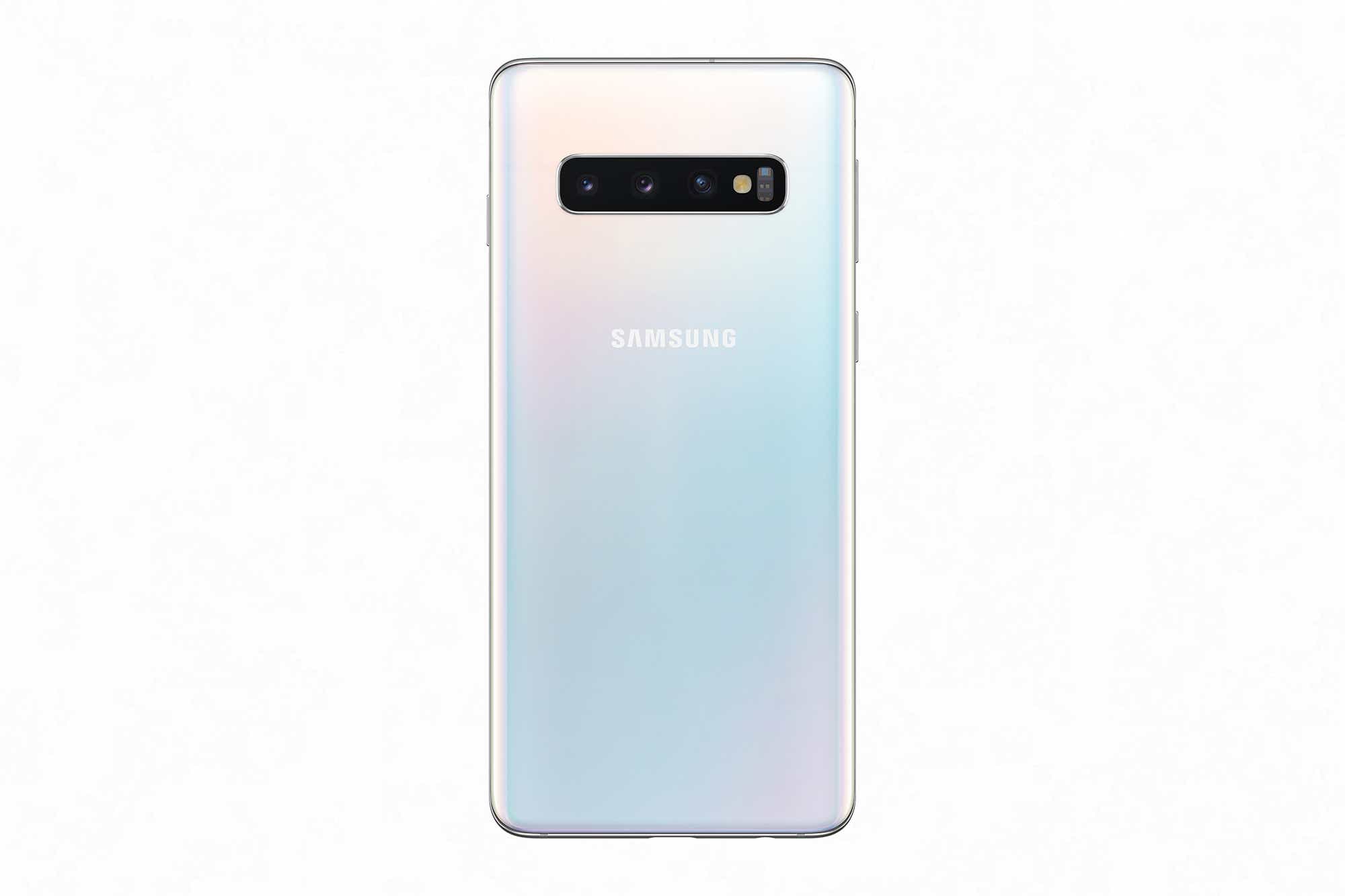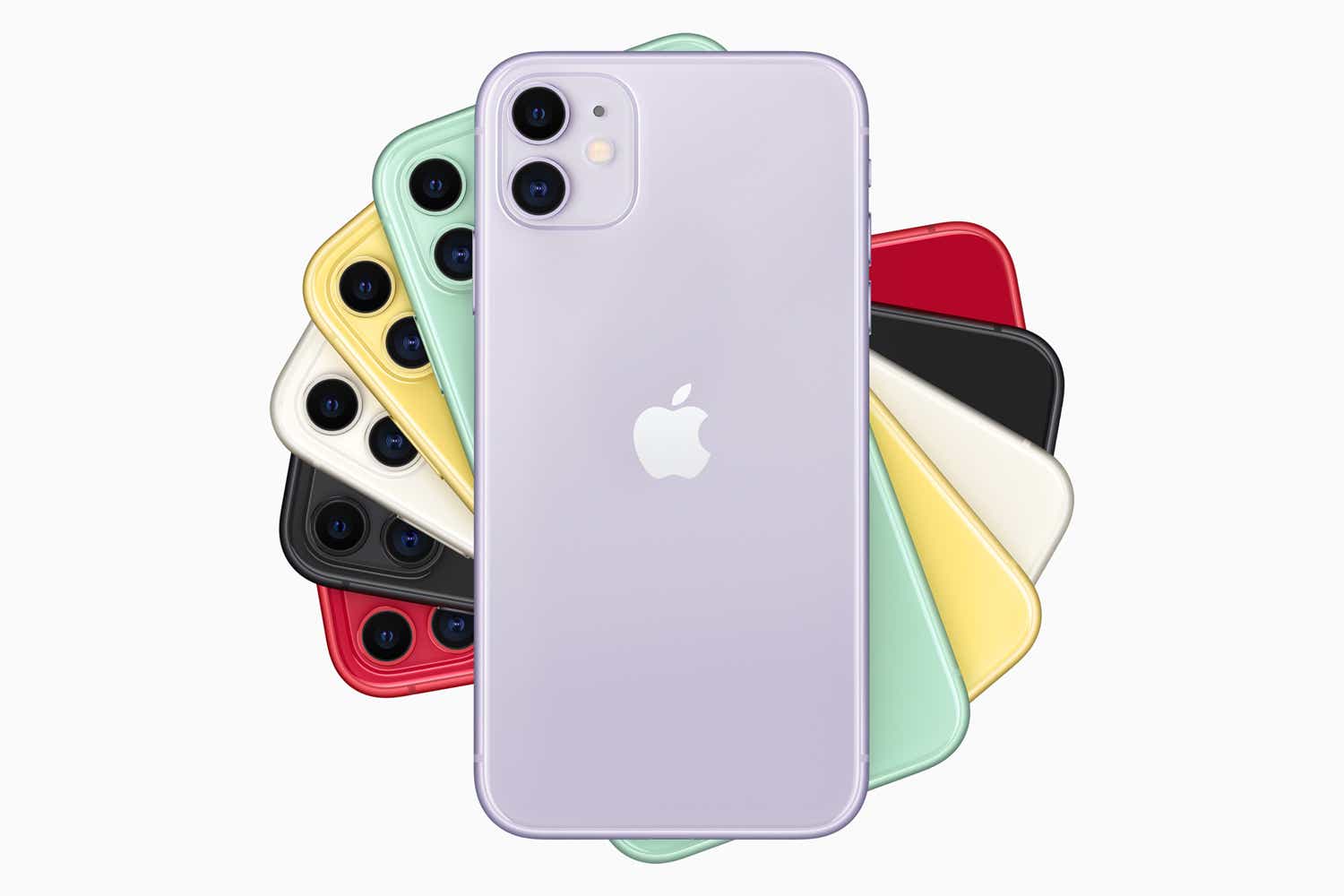It’s time to compare Apple’s iPhone to the leading Android handsets, and it should be a close race. From the launch of the first folding phone to the rise of 5G, dual screens, waterfall displays, and cameras, cameras, cameras, 2019 has delivered a dizzying array of new features. Apple may have surprised everyone with a price cut to its entry-level handset, but can it stack up to the best Android has to offer? Let’s go through the major specs and find out.
(Learn more about our favorite Android phones and how we test them in our guide to the best Android phones.)
The phones
Three phones compete against the iPhone 11 this year:
Samsung Galaxy S10+: I chose this model because it’s cheaper than the official flagship Note 10+. Also, compared to the S10, it’s a) only $100 more, and b) equipped with a much bigger battery. Google Pixel 4 XL: The newest Pixel phone has a laundry list of issues, but it’s Google so it gets the nod. Plus it has a better screen and bigger battery than the smaller one. OnePlus 7T: OnePlus is on a roll. The two phones released in the United States in 2019, the 7 Pro and the 7T, raised expectations for what an affordable model can deliver. The newer 7T offers killer specs and a price that undercuts the iPhone 11’s.
Design
While Samsung pushed design boundaries with an impressive reimagining of the Galaxy S10, the iPhone is starting to feel a little stale. It’s more symmetrical than the other phones here, but the notch, the thickish bezels, and the screen-to-body ratio leave much to be desired. It’s also the thickest of the bunch at 8.3mm.
The giant square camera is a polarizing look, and it makes the iPhone 11 wobble when it rests on a table. The camera bump matches your chosen handset color, and while the new purple and green are nice, the glossy back picks up fingerprints early and often. Rumors suggest that Apple may dump the notch and make other changes for the iPhone 12. I hope that’s the case.
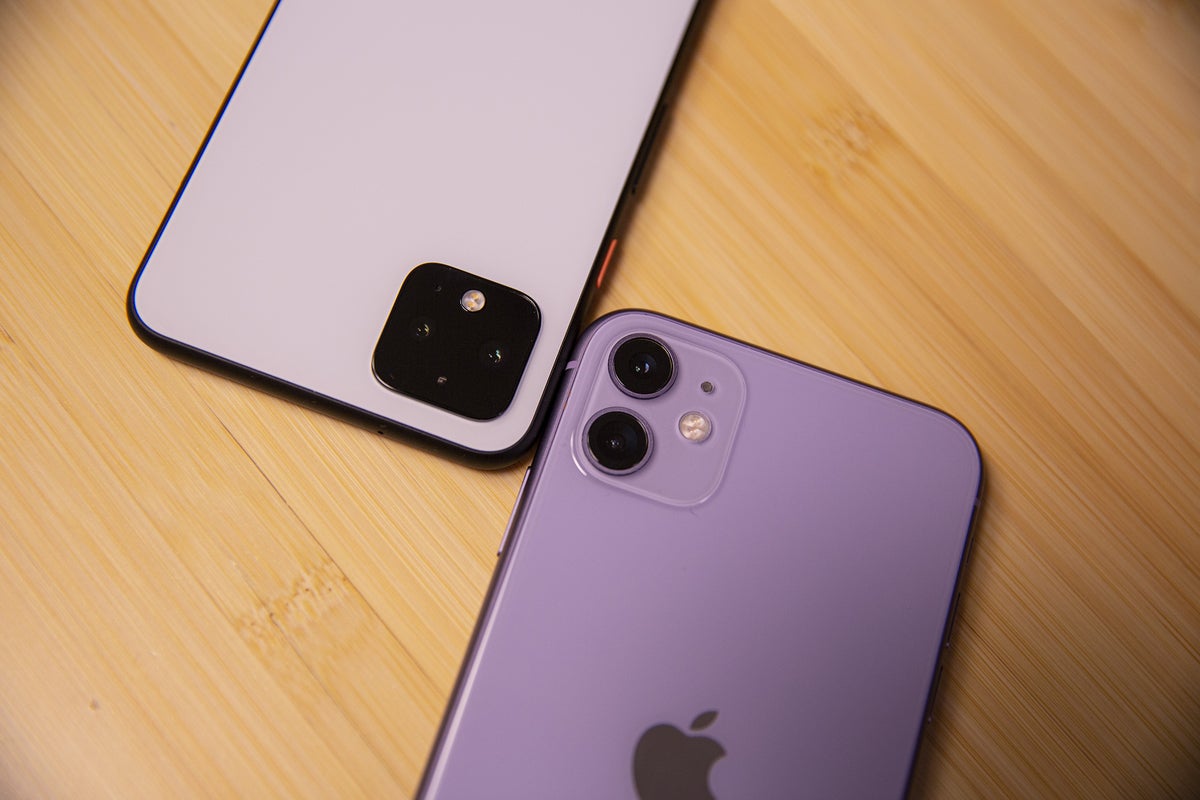 Christopher Hebert/IDG
Christopher Hebert/IDG
The Pixel 4 XL (left) and iPhone 11 have very similar camera stylings.
If the iPhone 11 is bland, the Pixel 4 XL is just plain blah. It loses last year’s notch for a sizable forehead, a small chin, and chunky side bezels. Like Apple, Google has added a square camera array in the upper left corner, but the Pixel 4’s bump is black regardless of body color.
I do like Google’s choice of materials, however. The luxurious frosted glass now covers the entire back of the phone, and it resists fingerprints, scratches, and smudges. The brushed-aluminum sides echo the frosted look, and the color options—which adds orange this year to the classics black and white—are appealing. I love the colored accent button. If Google ever decides to get serious about smartphone design, it should start with the materials and work backward.
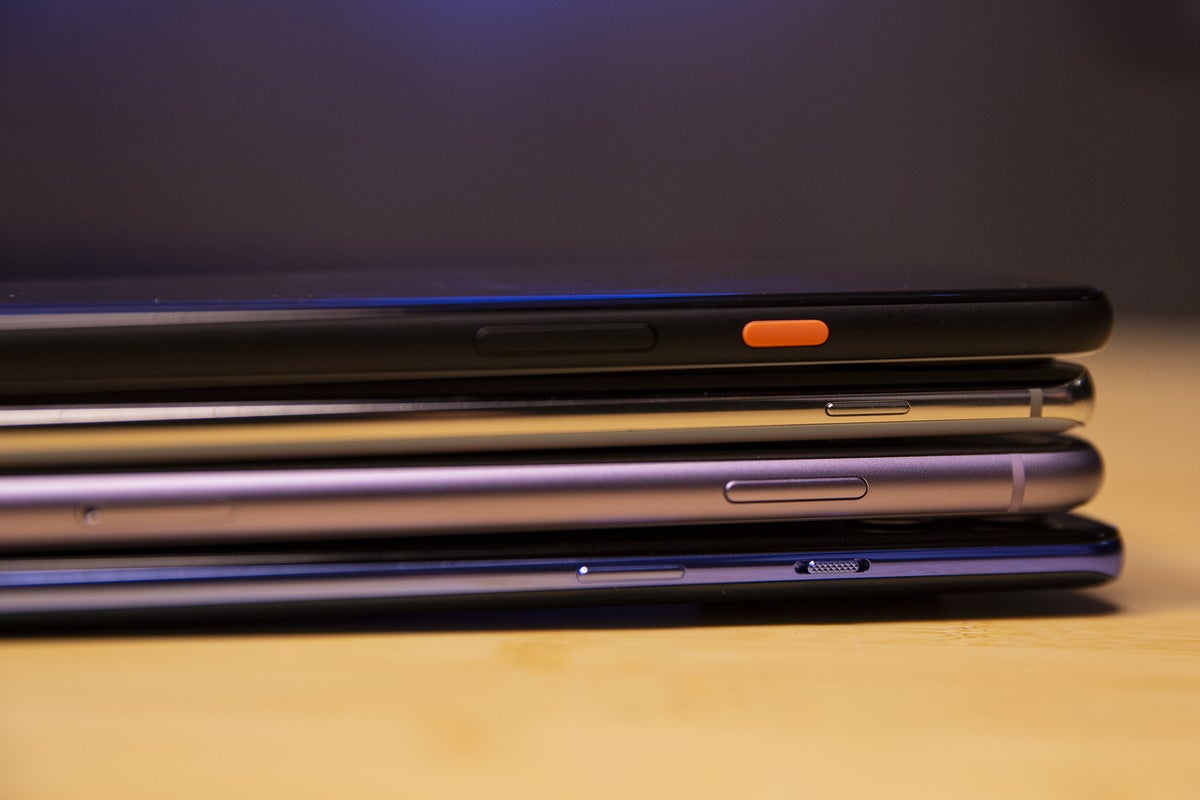 Christopher Hebert/IDG
Christopher Hebert/IDG
The Pixel 4’s orange power button remains my favorite feature about Google’s design.
Samsung’s S10+ continues to refine the Galaxy look. The top and bottom bezels are barely-there slivers, bringing the screen-to-body ratio close to 90 percent, but it feels like more because the edges of the screen drape over the sides. The back of the S10+ is just as pleasing, with a horizontal camera array set against a glass available in fantastic colors. Yes, it’s a fingerprint magnet, but so is the iPhone’s back. And unfortunately the lack of bezels brings visual and functional problems that Samsung isn’t yet prepared to address.
The oddball is the selfie camera. Lacking enough bezel to hide sensors, Samsung opted for a “hole-punch” camera literally embedded in the display, peering through a black circle in the upper right corner. Its off-center placement and funky design make it an eyesore.
 Christopher Hebert/IDG
Christopher Hebert/IDG
Surprisingly, the iPhone 11 (far right) is slightly thicker than the other phones here, but only by a tenth of a millimeter.
The OnePlus 7T may lack the pop-up selfie cam and edge-to-edge screen of the OnePlus 7 Pro, but its tiny “teardrop” notch, slim bezels, and thin body steal the show. Like the iPhone, the metal sides match your chosen color (blue or silver), setting off the all-black front nicely. The bezels aren’t much thicker than those on the S10+, and I prefer the flat look over the S10+’s infinity screen.
If the new trend is to spotlight the camera bump rather than try to hide it, the advantage again goes to OnePlus. The 7T’s giant circular camera array is unique, plus it’s the only phone here that can lie on a table without wobbling. I hope it remains a design element on future OnePlus phones. Winner: OnePlus 7T
Display
With such skinny bezels on all except the Pixel 4 XL, the display commands all of your attention. All of the OLEDs here are supplied by Samsung, while the iPhone 11 uses an LG LCD. They all feature HDR10 and Dolby Vision, and are impressively calibrated out of the box.
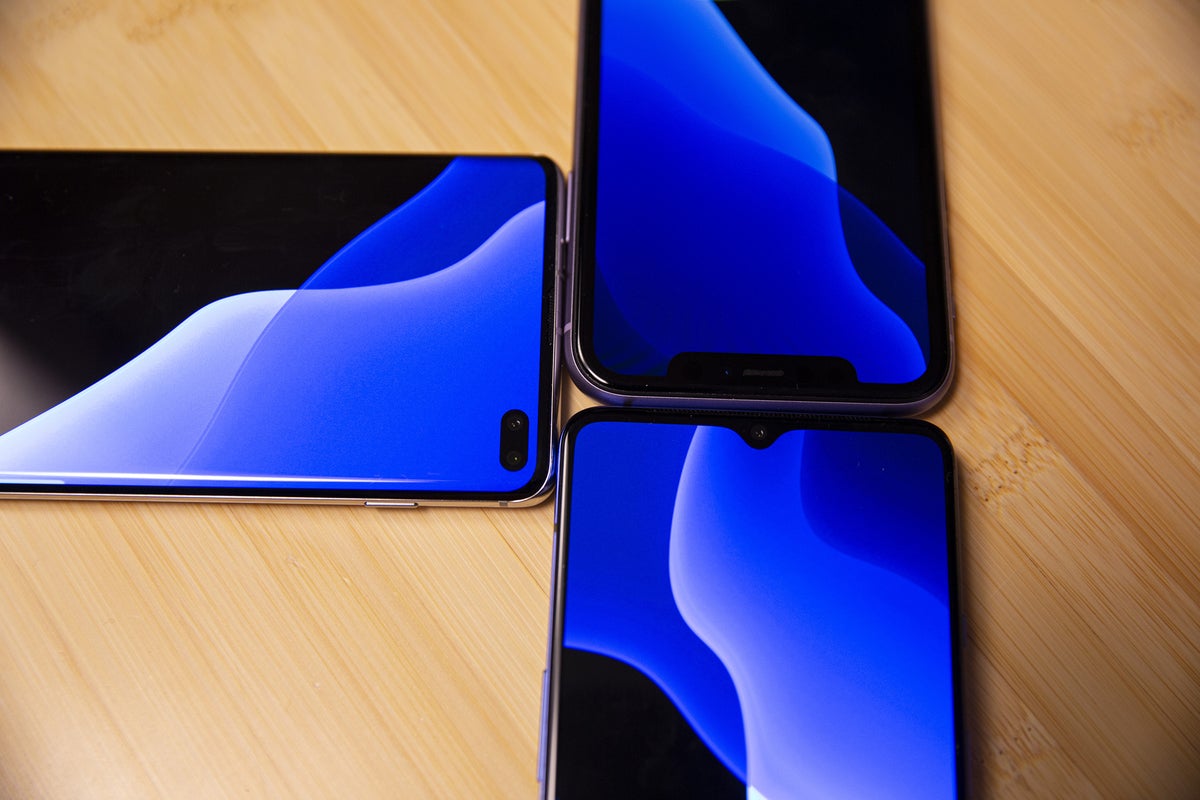 Christopher Hebert/IDG
Christopher Hebert/IDG
The OnePlus 7T (bottom) has the smallest camera cutout.
But they’re not created equal, especially in refresh rate. The standard is 60Hz, which is the default for all four phones, but the OnePlus 7T and Pixel 4 both feature 90Hz options. The extra 30 frames per second means scrolling and swiping feel faster, especially on the 7T. Google hamstrings the Pixel 4 XL somewhat by limiting this feature to screen brightnesses above 75 percent, though an upcoming software update will allegedly fix it.
Screen speed isn’t the only area where the 7T excels. The quad HD Galaxy S10+ may win for crispness and vividness, but the 7T is still bold, bright, and easy on the eyes. Like the iPhone 11’s, the OnePlus 7T’s display is something of a testament to how much you really need in a phone. It’s “only” full HD, doesn’t have curved edges, and lacks ambient and always-on options, but it still makes a strong showing.
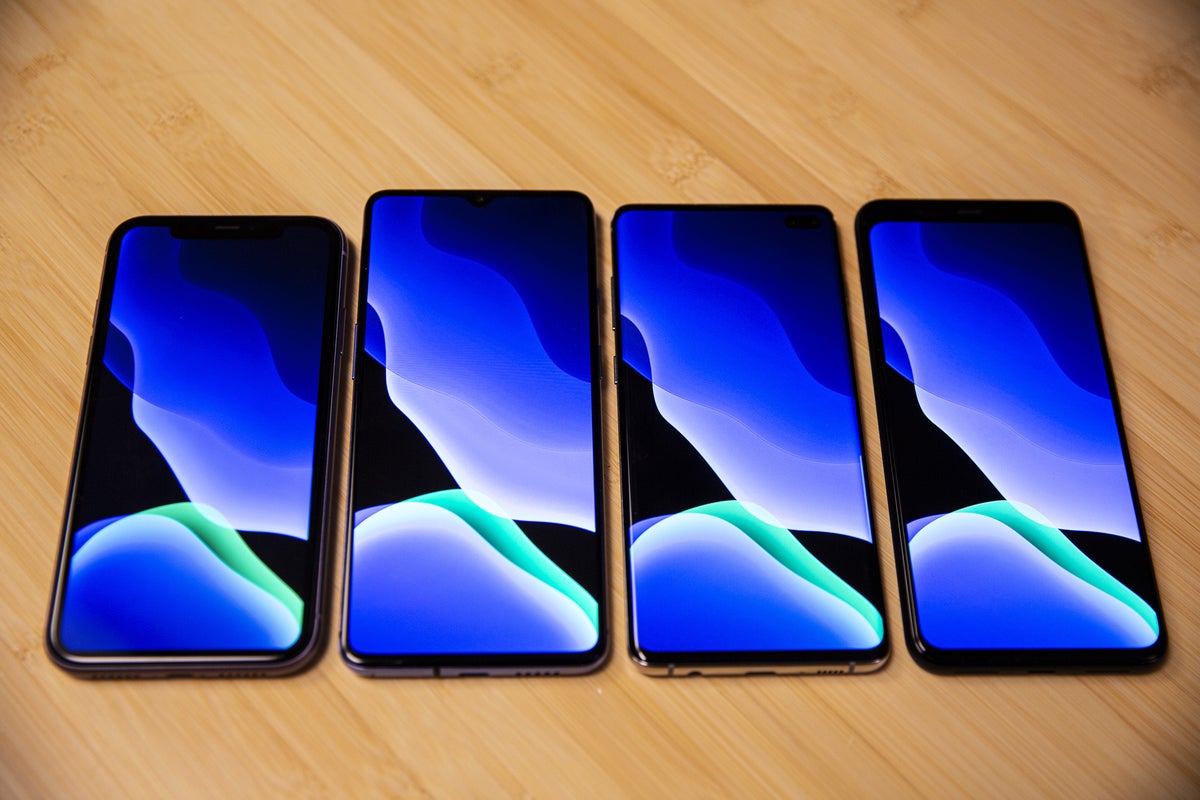 Christopher Hebert/IDG
Christopher Hebert/IDG
The iPhone 11, OnePlus 7T, Galaxy S10+, and Pixel 4 XL (left to right) all have top-notch displays.
As the only LCD of the bunch—and a 720p one at that—the iPhone 11 loses when it comes to depth. The blacks of an LCD can’t match those of an OLED, which is particularly evident when switching on the new iOS dark mode.
Apple has done a fantastic job with the calibration on the iPhone 11’s display. Colors are rich and vibrant, though I would like an always-on or ambient option, especially at night when the whole display needs to light up to check the time.
When it comes to brightness, the iPhone 11 shines, though the 7T was just a little better. However, in my testing with a simple white background, the 7T was also the most inconsistent.
Max brightness (nits)
- OnePlus 7T: 825
- iPhone 11: 765
- Galaxy S10+: 715
- Pixel 4 XL: 650
I’m confident in saying Google has delivered its best display in the Pixel 4 XL, but that’s mainly because the ones that came before were so disappointing. It still has Google’s trademark dullness, and an overall lack of punch when left in Natural mode. But even when switched to Boosted, the Pixel 4 XL just has a flatter feel when compared to the other phones here.
 Christopher Hebert/IDG
Christopher Hebert/IDG
The OnePlus 7T (right) bested the iPhone 11 when it came to brightness
The Pixel 4 is particularly lackluster when placed next to the Galaxy S10+. But to be fair, most phone displays are. The Galaxy S10+ pretty much set or broke every display record there is. There aren’t enough adjectives or superlatives to describe just how gorgeous the S10+’s screen is. My only want is a higher refresh rate—and I have to assume that’s coming with the S11. Winner: Samsung Galaxy S10+
Battery
Each phone has a respectable battery, but the S10+ is the clear standout on paper:
- Galaxy S10+: 4,100mAh
- OnePlus 7T: 3,800mAh
- Pixel 4 XL: 3,700mAh
- iPhone 11: 3,142 mAh
The real-world results don’t quite match up, however. In my testing and real-world use, the S10+ bested its competitors, but not by much, while the iPhone 11 vastly outperformed its capacity. The only one that consistently struggled to make it through a full day of use was the Pixel 4 XL. The iPhone 11 and 7T benefit from their lack of an always-on display, but some (including me) will miss that feature.
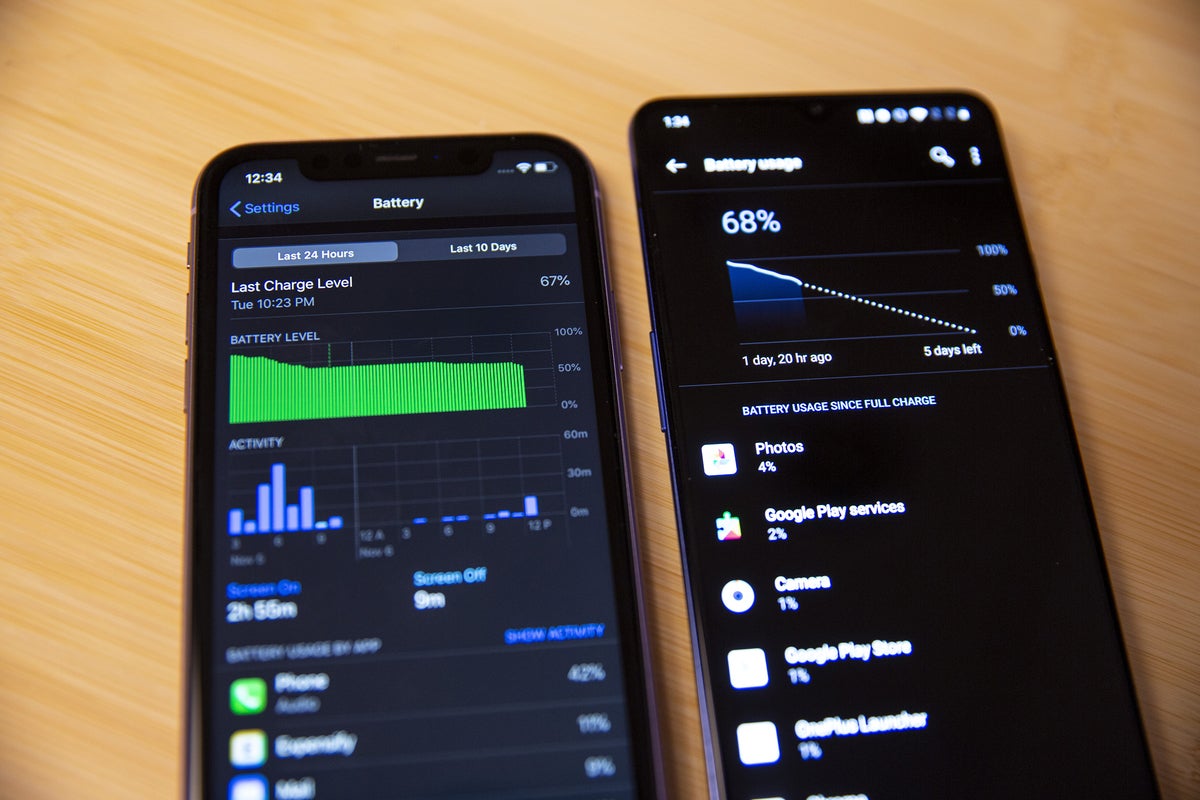 Christopher Hebert/IDG
Christopher Hebert/IDG
The iPhone 11 (left) has the best battery life, but not by much.
The Pixel 4 XL was the most disappointing. The same OS ownership that gives Apple a ridiculous edge should propel the Pixel 4 XL to heights unseen by other Android phones, but the reality doesn’t deliver. The lack of optimization is extremely frustrating.
For example, I played a two-hour movie at max brightness with all ambient and adaptive brightness toggles turned off, and this is how much battery each phone used:
- OnePlus 7T: 17%
- iPhone 11: 19%
- Galaxy S10+: 19%
- Pixel 4 XL: 21%
The results are pretty close, but those percentage points add up over the course of a day, especially because most people won’t be using their phones to watch videos for 10 hours straight. And look what happened when I ran the same video a second time with auto-and adaptive brightness turned on for all three phones, tracking the battery drain:
- iPhone 11: 13%
- OnePlus 7T: 18%
- Galaxy S10+: 19%
- Pixel 4 XL: 20%
Apple’s advantage comes into play when iOS starts working its magic. Even with a significantly smaller battery, the iPhone 11 is able to last longer than any of the phones here. All four handsets have lots and lots of pixels to power here, so lower brightness is definitely your friend. At the end of the day, the iPhone 11 consistently had the most juice left—and the Pixel 4 XL was always closest to the red—but every phone should get you through a normal day of use.
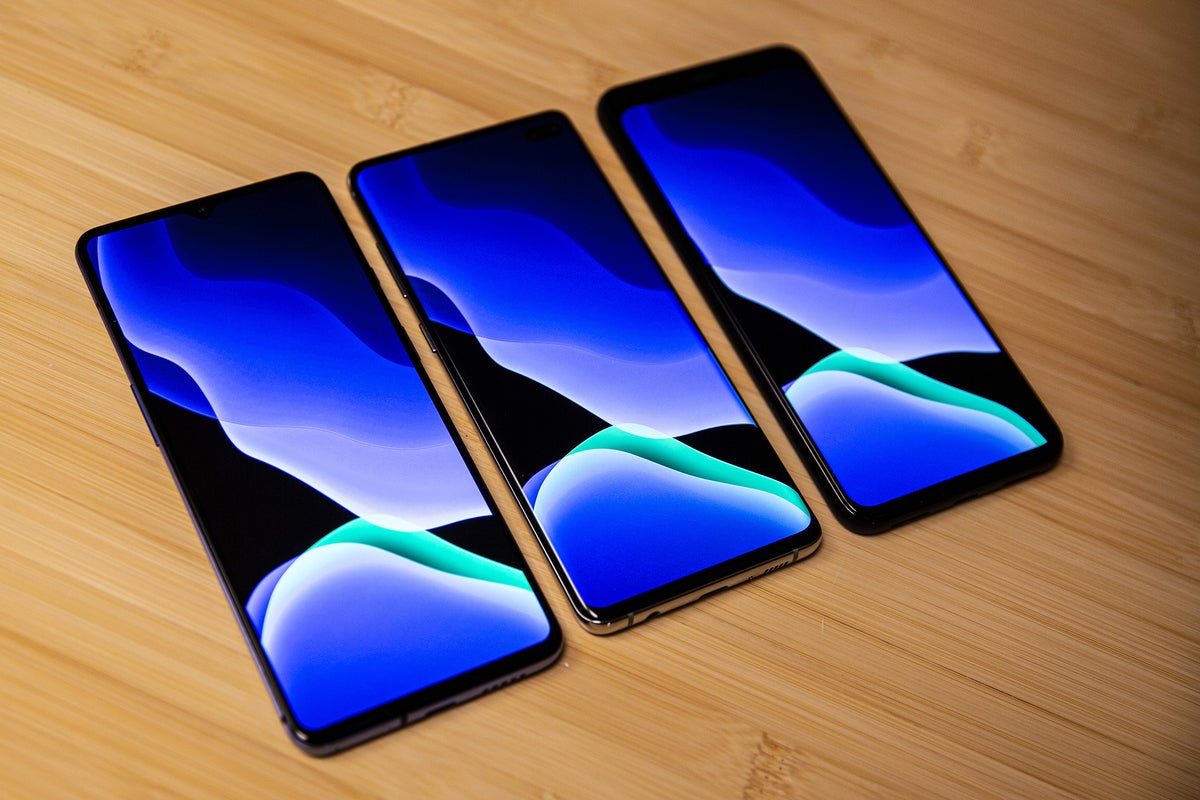 Christopher Hebert/IDG
Christopher Hebert/IDG
With giant screens and lots of pixels, the OnePlus 7T (left), Galaxy S10+ (center), and Pixel 4 XL (right) all have giant batteries.
It’s hard to crown a champion here, so I’ll say this: The iPhone 11 and the Galaxy S10+ will last the longest, the OnePlus 7T is just a tick below, and the Pixel 4 XL will constantly worry you. But if battery life is your deciding factor for any phone, go with the iPhone 11. Winner: iPhone 11/Galaxy S10+
Charging
We no longer need to wait hours to charge our phones—assuming you have the right charger. With a dead phone and the charger that’s included in the box, here’s how much juice you’ll have after an hour of charging:
- OnePlus 7T: 100%
- Pixel 4 XL: 77%
- Galaxy S10+: 74%
- iPhone 11: 33%
Two things here: The OnePlus 7T’s incredible Warp Charging, and the iPhone’s not-incredible 5W charger. While Apple’s “Pro” phones enjoy a swift 18W USB-C charger, the iPhone 11 is still saddled with a Lightning-based 5W plug. So if you buy one, you’ll want to pick up a way bigger third-party charger.
Speaking of big, the OnePlus 7T’s Warp Charge 30T is easily the biggest of the bunch, taking up the better of two outlets when plugged in—and you’ll be using it every day, because the OnePlus 7T is the only phone here that lacks wireless charging. The other three phones all offer it, though the top speeds vary slightly:
- Galaxy S10+: 12W
- Pixel 4 XL: 11W
- iPhone 11: 7.5W
Ironically, the iPhone 11 wirelessly charges faster than it does with its bundled charger. Some people might scoff at wireless charging as a reason to buy a phone, but I’d have a hard time without it. So the OnePlus 7T loses major convenience points, even with the stellar Warp Charge. Winner: Galaxy S10+
Read on for comparisons on performance and more.
Performance
All of the phones include very fast and very efficient processors. Obviously the iPhone uses Apple’s silicon, while the Android phones are powered by Qualcomm’s Snapdragon chipset.
Both the Galaxy S10+ and the Pixel 4XL use the Snapdragon 855 processor, while the OnePlus 7T sports the newer Snapdragon 855+. It would take a serious user with equally serious benchmarks to discern any difference, but OnePlus buyers can boast that they have the technically faster Android phone.
Something’s not quite right with the Pixel 4. It should be the fastest of the bunch, with the purest Android skin and Google’s hardware-software integration, but in test after test it performed slower than the others. It’s gotten worse since I wrote my review. Apps hang (including Google’s own utilities), system features lag, and even scrolling feels sluggish at times with Smooth Display turned on. It’s the only phone where I need regular restarts to keep things humming. I can only hope the performance issues will be fixed with an update. Just check out these BrowserBench Speedometer scores, which measure the responsiveness of web apps:
- iPhone 11: 153
- OnePlus 7T: 69.1
- Galaxy S10+: 53.8
- Pixel 4 XL: 34
I ran this test several times on the Pixel 4 using Google’s own Chrome browser, and it never topped 35. Meanwhile, the A13 Bionic chip in the iPhone 11 is on another level—faster than its predecessor and the fastest of the bunch here, including in real-world results. Even the fastest Android UI here feels sticky when compared to the iPhone 11, and that’s without a 120Hz ProMotion display.
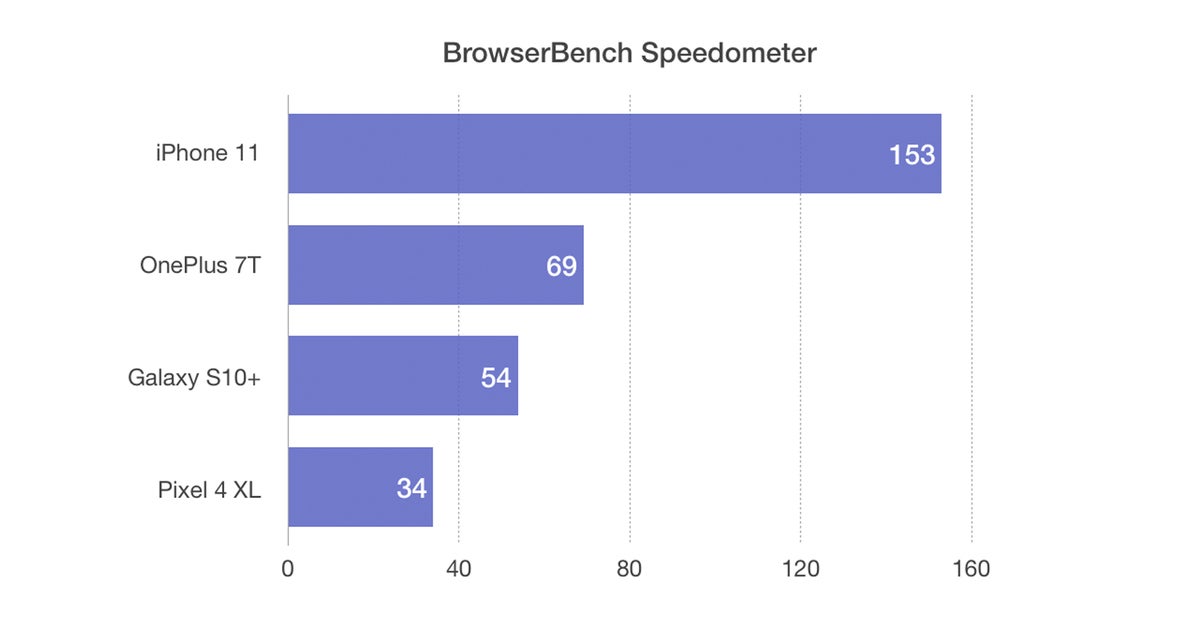 IDG
IDG
The iPhone 11 performs more than twice as many browser tasks as the closest top-of-the-line Android phone.
The harmony Apple creates between the silicon and software is second to none, as evidenced by these Geekbench benchmark score (where once again the Pixel 4 seriously lags):
CPU (Single-Core/Multi-Core)
- iPhone 11: 1,330/3,531
- OnePlus 7T: 791/2,789
- Galaxy S10+: 710/2,639
- Pixel 4 XL: 635/2,529
Compute
- iPhone 11: 6,402
- OnePlus 7T: 2,693
- Galaxy S10+: 2,397
- Pixel 4 XL: 2,105
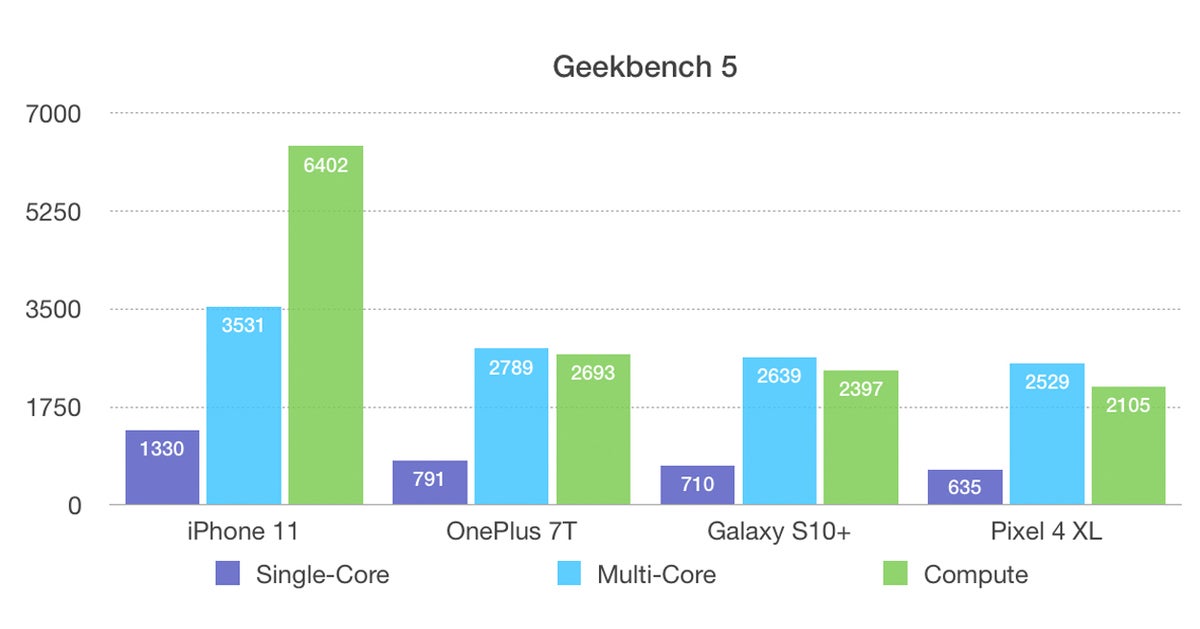 IDG
IDG
The A13 Bionic processor in the iPhone 11 simply smokes the competition.
One area where Apple can improve, however, is startup time from a full shutdown. The Pixel 4 XL obliterated the other phones, and the iPhone consistently came in last place, even if only by a second or two:
- Pixel 4 XL: 11 seconds
- Galaxy S10+: 19 seconds
- OnePlus 7T: 20 seconds
- iPhone 11: 21 seconds
Granted, we rarely restart our phones—and the iPhone needs it even less often than the Android phones here—but I’d still like to see Apple get closer to the Pixel with the iPhone 12.
The results here underscore my frustrations with the Pixel 4 XL: If Google can optimize startup time, why can’t it do the same with the rest of Android? The Galaxy S10+ and OnePlus 7T basically run circles around the Pixel 4, but neither can touch the iPhone’s crazy speeds, even if you won’t notice them much. Winner: iPhone 11
Sound
After Apple famously dumped the headphone jack with the iPhone 7, the rest of the industry has slowly followed suit. First Google took it away from the Pixel 2, then OnePlus removed it with last year’s 6T. And once it’s gone, it’s not coming back.
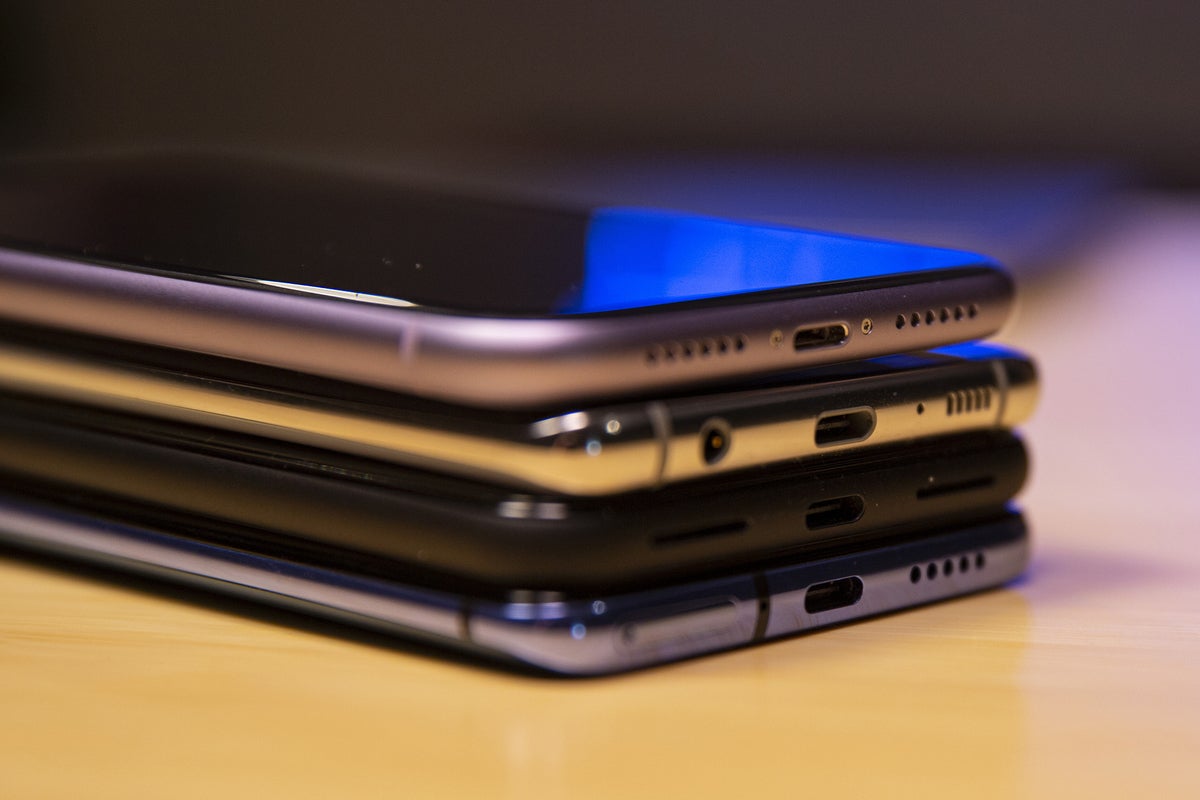 Christopher Hebert/IDG
Christopher Hebert/IDG
The headphone jack is going away, but the Galaxy S10+ still has one.
The Galaxy S10+ is the sole phone in the bunch that retains a 3.5mm headphone jack. You even get a very decent pair of AKG-tuned earbuds in the box. But Samsung axed the headphone jack from the Note 10 and Galaxy Fold, so you can see the writing on the wall. You’ll get a pair of Lightning EarPods with the iPhone 11, but neither the OnePlus 7T nor the Google Pixel 4 XL includes a pair of buds, nor a USB-C-to-3.5mm dongle. The phones’ own speakers also deliver solid volume (the Pixel 4 loses its front-firing speakers, which gave it a serious sound boost last year).
Max decibels
- Galaxy S10+: 100
- Pixel 4 XL: 98
- OnePlus 7T: 97
- iPhone 11: 94
Along with their loudness, every handset but the Pixel 4 boasts Dolby Atmos spatial sound. While it’s debatable that you actually need Dolby Atmos support on a phone, it’s nice to have. Supported music and movies definitely feel slightly fuller (though you’re not going to forget you’re listening on a pair of smartphone speakers). Winner: Galaxy S10+
Biometrics
We’re at something of a transitional period when it comes to biometrics. OnePlus and Samsung replaced the physical fingerprint sensor with an in-display scanner, while the iPhone 11 and Pixel 4 both use 3D facial recognition. The Galaxy S10+ has a better scanner than the OnePlus 7T, and the iPhone tops the Pixel 4 XL with facial recognition, but there’s more to the story than that.
The Galaxy phones used to have an iris scanner in addition to a fingerprint reader, so the in-display sensor feels like a step backward, especially because it’s neither as fast nor as reliable as the physical scanner. Meanwhile, the OnePlus 7T’s scanner is faster than Samsung’s when it works—especially when paired with the 2D face unlock. But on the whole I struggled with it more than I did with the S10+. Both phones have continuously improved their sensors through software updates.
Apple’s had two years to refine Face ID. It’s speedy, secure, and simple, with smart features that help keep your data locked down.
That’s not the case with Google’s face unlock. It’s very fast and will even work if you’re holding your phone upside down, but it’s missing a key feature: attention, both in the literal and figurative sense. Google has opted against including eye tracking in the initial version, so if your eyes are closed, someone could still hold your phone up to your face to unlock it. Winner: iPhone 11
Storage
We’ve kind of reached the point where no one should ever run out of space on their phones, but just for the fun of it, let’s break down the dollar-to-gigabyte ratio:
- OnePlus 7T (128GB): $4.68
- Galaxy S10+ (128GB): $7.81
- iPhone 11 (64GB): $10.92
- Pixel 4 XL (64GB): $14.05
That’s a pretty big disparity, and you don’t need to be a math whiz to figure out that more gigabytes for less money equals better value. The same goes for the step-up models:
- iPhone 11 (64GB upgrade, $50): $0.78
- Galaxy S10+ (384GB upgrade, $250): $0.65
- Pixel 4 XL (64GB upgrade, $100): $1.56
- OnePlus 7T: N/A
It’s a bummer that OnePlus isn’t offering a storage upgrade option for the 7T in the U.S., but even so, it delivers the best internal storage value. It’s also a bummer that Google continues to sell 64GB of extra storage for $100, and no other Android phone here other than the S10+ offers an expandable memory card slot. But dollars-to-gigabytes, the OnePlus 7T takes this category. Winner: OnePlus 7T
Let’s talk about smartphone brains: iOS and Android, are they really much better or worse? Keep reading to find out.
OS
I could spend the next several hundred words debating the differences between iOS and Android and trying to convince you why the iPhone 11 has stronger app support and better gesture navigation, or why Google Assistant is superior to Siri and notifications are actually quite good on Android.
But the fact of the matter is, for every point I make about one, an equally salient point could be made about the other. The scale of iOS has lead to widespread bugs and issues that Apple struggles to squash, while Android’s fragmentation and generally slow update schedule is continuously frustrating. The two operating systems are extremely close now—heck, they both even have dark mode.
 Christopher Hebert/IDG
Christopher Hebert/IDG
Whichever phone you choose, you’re getting a great, modern OS.
So let’s talk about Android vs Android instead. We often refer to Android as a universal OS, but each phone brings a very different interpretation, affecting the overall experience as much as the specs and the hardware. Here’s what you get with the phones here:
- Galaxy S10+: One UI
- Pixel 4 XL: Android 10
- OnePlus 7T: OxygenOS 10
The One UI Android skin on the Galaxy S10+ is the most unique of the bunch, as far away from stock Android as a Galaxy phone has ever been. It’s also the smartest interface Samsung has ever designed, with intuitive controls, thoughtful layouts, and powerful apps. As the first Galaxy to ship with One UI, the S10+ easily delivers the best end-to-end Samsung experience in years. Major updates are still an issue—One UI 2 based on Android 10 likely won’t arrive until 2020—but Samsung has done a fantastic job with crafting an OS that’s all its own.
The OnePlus 7T is one of the very few phones to ship with Android 10. Its Oxygen OS skin is every bit as light and airy as its name suggests. It sticks close to Google’s vision of Android and even feels like an Android One phone at times. However, powerful customization and smart features, plus a healthy dose of speed, give Oxygen OS its own character while still giving Android purists enough to love.
The Pixel 4’s main reason to exist is as a showcase for the latest Android build, so like the OnePlus 7T, it ships with Android 10 on board. But unlike the iPhone 11, which runs iOS 13 like it was tailor-made (because it was), I encountered more issues with Android 10 on the Pixel 4 than I have with any other Pixel phone. App crashes and hangs, laggy scrolling, and general slowness has plagued my time with it. Worse, the November update that should fix things has been slow to reach my phone. Software problems with new phones are hardly uncommon—Apple certainly has its share of them each year—but the Pixel is supposed to represent the best of Android, and so far the Pixel 4 doesn’t. Winner (Android): OnePlus 7T
Miscellaneous features
Each phone offers apps and features that are unique to the experience. The Galaxy S10+ has its Edge shortcuts, which let you swipe from the curved area of the screen to access apps. The OnePlus 7T has a Reading Mode that desaturates the screen to make it easier on the eyes. The iPhone 11 has Animoji and FaceTime.
They also all have some form of water resistance, though the OnePlus 7T isn’t IP-rated, so we don’t know how deep you can dunk it. On paper, the iPhone 11 is the most resistant, letting you submerge it in 2 meters of water for up to 30 minutes. (The Pixel 4 and S10+ guarantee a depth of only 1.5 meters).
The Pixel 4 brings something that you won’t find on the other phones here. Called Motion Sense, it lets you control parts of your phone by waving your hand above the screen. It’s limited to snoozing alarms, skipping tracks, and silencing calls for now, but it works extremely well and has incredible potential. In a world of near-homogeneity when it comes to smartphones, I commend Google for thinking and engineering out of the box with the Pixel 4. Winner: Pixel 4 XL
Camera
The camera is probably the main thing people research when buying a new phone, and I’m just going to say it here: Each of these phones’ default cameras will take fantastic pictures out of the box without adjusting a single setting, despite some differences and deficiencies, as you’ll see here.
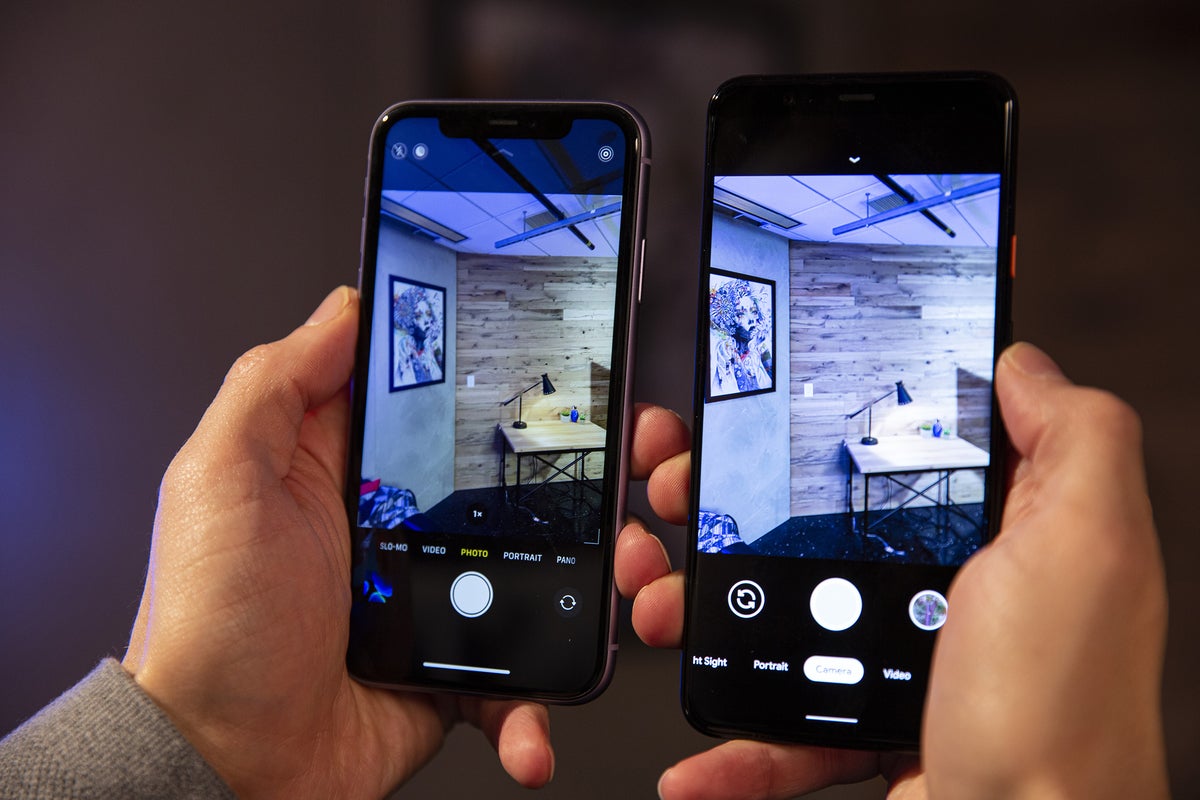 Christopher Hebert/IDG
Christopher Hebert/IDG
The iPhone 11 (left) and Pixel 4 XL (right) don’t have a ton of manual controls, but they still take the best pictures.
All have multiple cameras, but you’re getting only two with the Pixel 4 XL (standard, telephoto) and the iPhone 11 (standard, ultra wide), while the S10+ and 7T have three apiece (standard, ultra wide, telephoto).
The funky placement of the iPhone 11’s cameras have a purpose: It’s the only camera where you don’t have to adjust your shot when switching from standard to ultra-wide. It’s a small but meaningful attention to detail.
If you’re looking for the fastest, most accurate, most versatile, then the iPhone 11 is your champ, just barely beating out the Pixel 4 XL. Neither Google nor Apple offer users the manual controls in the stock camera app that the OnePlus 7T and the Galaxy S10+ do, but you wouldn’t need them if they did. The photo processing on the iPhone 11 and Pixel 4 are far enough ahead of the other phones here where you can be absolutely confident that you’re getting the best possible picture when you tap the shutter, no matter the subject, mode, or lighting condition.
The bigger jump over last year can be seen in the iPhone 11’s Night Mode. While it will be criticized by some as merely playing catch-up to Google’s Night Sight, which debuted to wows on the Pixel 3, Night Mode is a revelation for nighttime photography, with a mind-blowing algorithm that produces better results than the Pixel 4 in some instances.
The iPhone excels in its understanding of what’s being shot. Other night modes simply amp up the brightness and exposure with varying results, while the iPhone 11 does a better job of preserving the shadows and overall integrity of the scene.
While both the iPhone 11 and the Pixel 4 XL usually snuffed the competition, more often than not, I preferred the nuance in the iPhone 11’s shot. Where the Pixel 4 XL’s Night Sight shots often seem like a Photoshop brightening filter had been applied, which affected clarity and sharpness, the iPhone 11’s shots had deeper blacks, crisper details, and less overall noise and graininess.
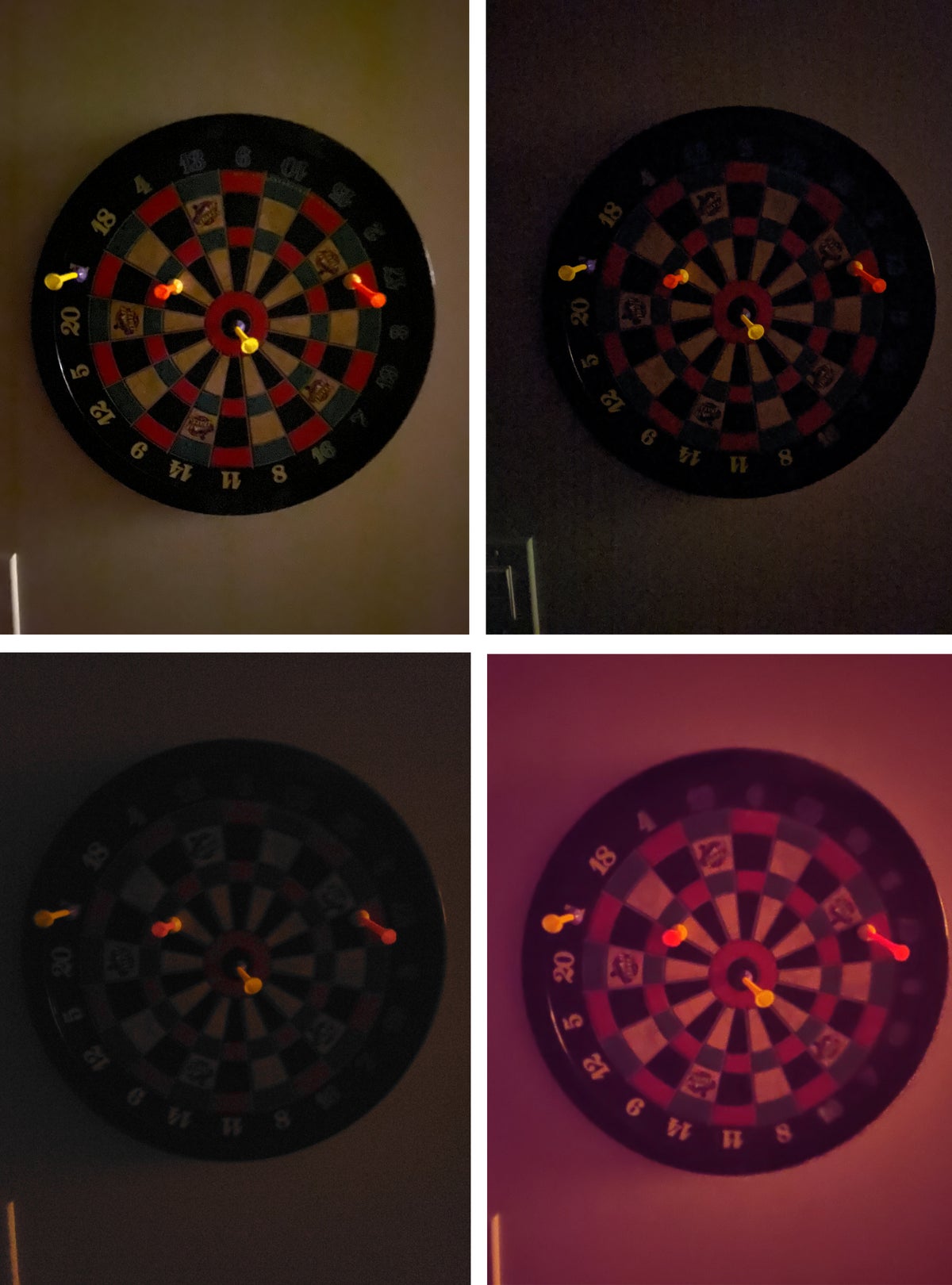 Christopher Hebert/IDG
Christopher Hebert/IDG
The iPhone 11 (top left) handled this extremely dark scene better than the Pixel 4 XL (top right), the Galaxy S10+ (bottom left), and OnePlus 7T (bottom right).
Small details aside, at times the iPhone 11 simply floored the competition. As you can see in the comparison shots above, all four phones did well with pulling out the color of the darts, but the board on the wall is another story. The OnePlus 7T struggled mightily with white balance (a constant issue when shooting in low light with white backgrounds), and the numbers in the S10+’s shot are barely visible. The Pixel 4 handled the color well, and illuminated the colors in the board and most of the bottom numbers, but the iPhone 11 was the only one of the bunch to illuminate all of the numbers (even if some aren’t legible) and properly brighten the wall.
 Christopher Hebert/IDG
Christopher Hebert/IDG
The Galaxy S10+ (bottom left) handled my son’s messy hair slightly better than the others in this portrait shot, but it’s hard to find fault with the iPhone 11 (top left), Pixel 4 XL (top right), or OnePlus 7T (bottom right).
When shooting in normal light, however, the differences aren’t nearly as extreme. In the portrait examples above, each camera handles the background blur (and my son’s messy hair) very well. You can quibble with skin tone and saturation (I personally prefer the Pixel 4 XL’s), but for the most part they all handle portraits very well.
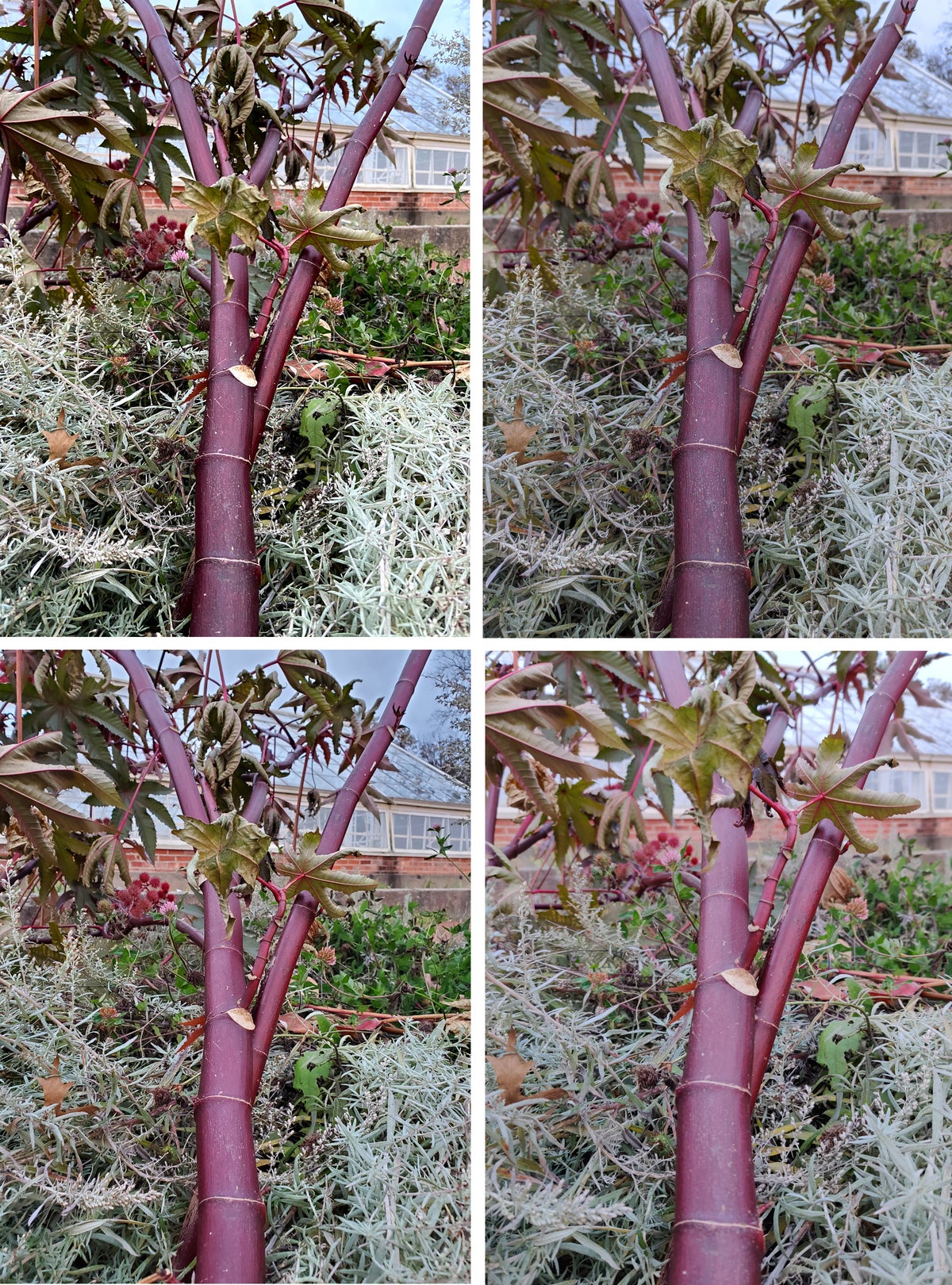 Christopher Hebert/IDG
Christopher Hebert/IDG
The iPhone 11 (top left) nailed the color and captured more detail in this shot of a tree trunk, but the Pixel 4 XL (top[ right), Galaxy S10+ (bottom left) and OnePlus 7T (bottom right) weren’t far behind.
Everyday shots come down to little details as well. Take these shots of a plant, above. Good bark, contrast, and color detail are present in all four pictures, but you can see how the OnePlus 7T lags a bit compared to its higher-priced peers, mainly due to autofocus issues. The iPhone 11 and Pixel 4 XL captured the deep maroon best, but again, I’m splitting hairs.
 Michael Simon/IDG
Michael Simon/IDG
The OnePlus 7T might not be on the same level as the iPhone 11 or Pixel 4 XL, but it’s capable of taking mind-blowing pictures.
For example, if you had to guess which camera took the photos above, you’d probably guess the iPhone 11 or Pixel 4, but they were actually snapped with the OnePlus 7T. Granted they were taken in ideal lighting, but they underscore just how far OnePlus has come with its smartphone photography. Winner: iPhone 11
Price
While you’d expect to pay about the same price for any of four smartphones with the best processor, screen, design, and cameras you can buy, that’s not the case:
- OnePlus 7T: $599
- iPhone 11: $699
- Pixel 4 XL: $899
- Galaxy S10+: $1,000
That’s a $400 gap between the Galaxy S10+ and the OnePlus 7T, and well, if you’ve gotten this far, you know that the S10+ isn’t $400 better than the 7T. Quite frankly it’s not $300 better than the iPhone 11, either. Apple shocked the world by lowering the price of the iPhone 11 compared to its iPhone XR predecessor, but for all you’re getting with the 7T, the other phones here just can’t compete. Winner: OnePlus 7T
Conclusions
With all due respect to the Pixel 4 XL, this is a three-phone race. Tally the category winners, and it’s a close call between the iPhone 11, Galaxy S10+, and OnePlus 7T. You won’t regret buying any of them, but the one you’ll feel just a little better about is the OnePlus 7T.
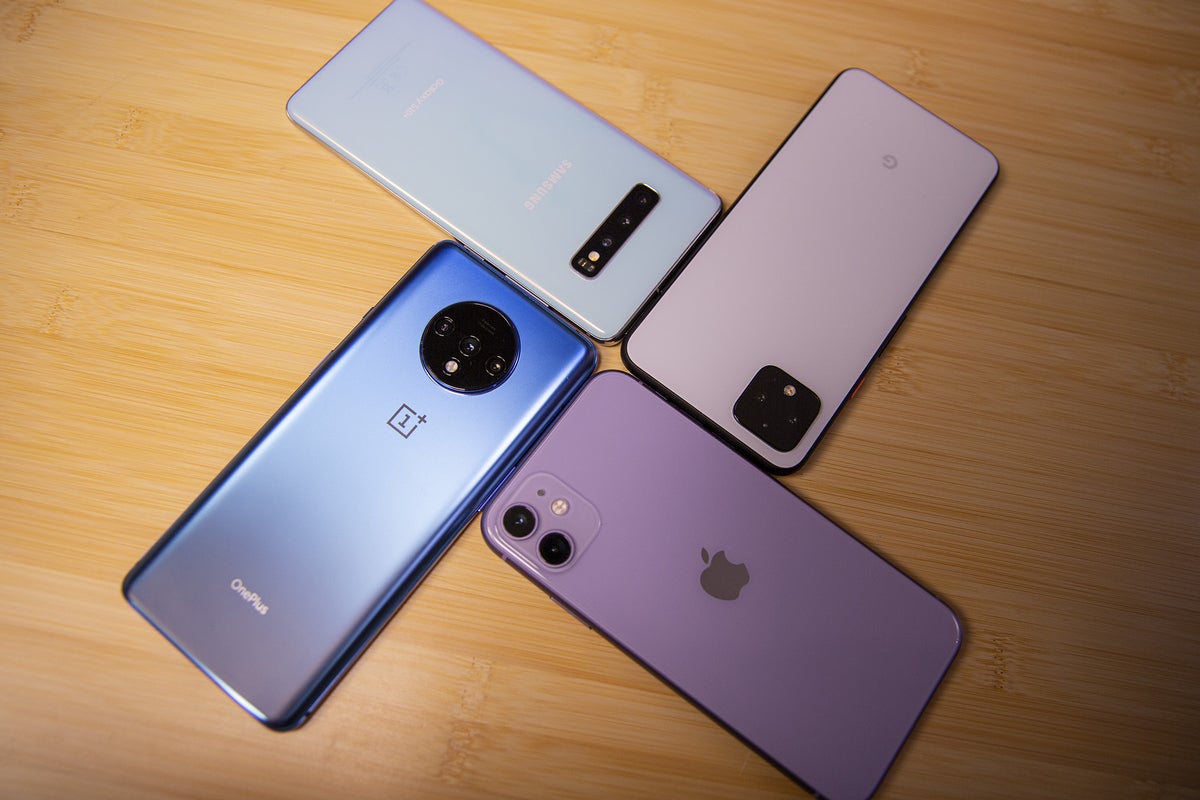 Christopher Hebert/IDG
Christopher Hebert/IDG
The rear of the phones have even more character than the front.
OnePlus phones have long been our pick for best value in a smartphone, but it’s time to recognize the 7T for what it is: a legitimate flagship that costs hundreds of dollars less than it should. Where things like the camera, design, and network compatibility used to drag down its predecessors, the 7T is a milestone for OnePlus, putting every other Android phone on notice—and the iPhone 11.
Yes the iPhone does some things better—and the lack of wireless charging on the OnePlus 7T is frustrating—but as a full package that’s $100 cheaper, it’s easy to recommend the OnePlus 7T to anyone in the market for a new phone, no matter which operating system they want.

